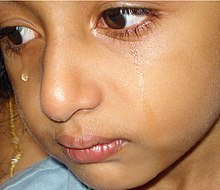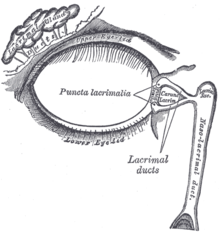What Did You Call Me a Cry Baby Meme

Crying is the dropping of tears (or welling of tears in the eyes) in response to an emotional country, or pain. Emotions that can lead to crying include sadness, anger, and even happiness. The act of crying has been defined as "a complex secretomotor miracle characterized by the shedding of tears from the lacrimal apparatus, without any irritation of the ocular structures", instead, giving a relief which protects from conjunctivitis.[1] A related medical term is lacrimation, which besides refers to not-emotional shedding of tears. Various forms of crying are known as sobbing, weeping, wailing, whimpering, bawling, and blubbering.[2]
For crying to be described as sobbing, it usually has to be accompanied by a set up of other symptoms, such as slow but erratic inhalation, occasional instances of breath holding and muscular tremor.
A neuronal connection between the lacrimal gland and the areas of the human brain involved with emotion has been established.
Tears produced during emotional crying take a chemical limerick which differs from other types of tears. They contain significantly greater quantities of the hormones prolactin, adrenocorticotropic hormone, and Leu-enkephalin,[three] and the elements potassium and manganese.[4]
Function [edit]

Two women weep at a funeral
The question of the function or origin of emotional tears remains open. Theories range from the simple, such every bit response to inflicted pain, to the more than complex, including nonverbal advice in order to arm-twist altruistic helping behavior from others.[5] [vi] Some have besides claimed that crying tin serve several biochemical purposes, such as relieving stress and clearance of the eyes.[seven] There is some empirical evidence that crying lowers stress levels, potentially due to the release of hormones such every bit oxytocin.[8] [9] Crying is believed to be an outlet or a result of a burst of intense emotional sensations, such equally agony, surprise or joy. This theory could explain why people cry during cheerful events, as well as very painful events.[10]
Individuals tend to remember the positive aspects of crying, and may create a link between other simultaneous positive events, such as resolving feelings of grief. Together, these features of memory reinforce the idea that crying helped the individual.[xi]
In Hippocratic and medieval medicine, tears were associated with the bodily humors, and crying was seen as purgation of excess humors from the brain.[12] William James thought of emotions as reflexes prior to rational thought, believing that the physiological response, every bit if to stress or irritation, is a precondition to cognitively becoming enlightened of emotions such every bit fear or anger.
William H. Frey Ii, a biochemist at the University of Minnesota, proposed that people feel "improve" later crying due to the elimination of hormones associated with stress, specifically adrenocorticotropic hormone. This, paired with increased mucosal secretion during crying, could pb to a theory that crying is a machinery developed in humans to dispose of this stress hormone when levels grow too high.[thirteen] Tears accept a express ability to eliminate chemicals, reducing the likelihood of this theory.[14]
Recent psychological theories of crying emphasize the human relationship of crying to the experience of perceived helplessness.[xv] From this perspective, an underlying experience of helplessness can usually explain why people cry. For example, a person may cry later on receiving surprisingly happy news, ostensibly because the person feels powerless or unable to influence what is happening.
Emotional tears accept also been put into an evolutionary context. Ane study proposes that crying, by blurring vision, tin can handicap aggressive or defensive actions, and may function equally a reliable point of appeasement, demand, or attachment.[16] Oren Hasson, an evolutionary psychologist in the zoology section at Tel Aviv University believes that crying shows vulnerability and submission to an assaulter, solicits sympathy and aid from bystanders, and signals shared emotional attachments.[17]
Another theory that follows evolutionary psychology is given by Paul D. MacLean, who suggests that the vocal part of crying was used offset as a "separation cry" to help reunite parents and offspring. The tears, he speculates, are a result of a link betwixt the development of the cerebrum and the discovery of fire. MacLean theorizes that since early on humans must have relied heavily on fire, their eyes were frequently producing reflexive tears in response to the fume. As humans evolved the fume possibly gained a strong association with the loss of life and, therefore, sorrow.[12] : 90–91 In 2017, Carlo Bellieni analysed the weeping behavior, and ended that most animals can cry but only humans have psychoemotional shedding of tears, also known as "weeping". Weeping is a behavior that induces empathy maybe with the arbitration of the mirror neurons network, and influences the mood through the release of hormones elicited by the massage result made by the tears on the cheeks, or through the relief of the sobbing rhythm.[18] Many ethologists would disagree.[19] [ page needed ]
Biological response [edit]

It can exist very difficult to discover biological effects of crying, specially considering many psychologists believe the environment in which a person cries tin can alter the experience of the crier. Laboratory studies have shown several physical furnishings of crying, such every bit increased eye rate, sweating, and slowed breathing. Although information technology appears that the type of effects an individual experiences depends largely on the individual, for many it seems that the calming effects of crying, such as slowed animate, outlast the negative effects, which could explain why people call up crying every bit existence helpful and beneficial.[20]
Globus sensation [edit]
The about common side result of crying is feeling a lump in the throat of the crier, otherwise known every bit a globus sensation.[21] Although many things can cause a globus sensation, the 1 experienced in crying is a response to the stress experienced past the sympathetic nervous system. When an beast is threatened past some form of danger, the sympathetic nervous organisation triggers several processes to let the animal to fight or abscond. This includes shutting downwardly unnecessary body functions, such as digestion, and increasing blood flow and oxygen to necessary muscles. When an private experiences emotions such every bit sorrow, the sympathetic nervous organization even so responds in this manner.[22]
Some other function increased past the sympathetic nervous system is breathing, which includes opening the throat in order to increase air flow. This is done by expanding the glottis, which allows more air to pass through. As an individual is undergoing this sympathetic response, eventually the parasympathetic nervous organization attempts to undo the response by decreasing high stress activities and increasing recuperative processes, which includes running digestion. This involves swallowing, a process which requires endmost the fully expanded glottis to prevent nutrient from entering the larynx. The glottis attempts to remain open up as an individual cries. This fight to shut the glottis creates a awareness that feels like a lump in the private's throat.[23]
Other common side effects of crying are quivering lips, a runny olfactory organ, and an unsteady, keen voice.
Frequency [edit]
According to the German Gild of Ophthalmology, which has collated different scientific studies on crying, the boilerplate adult female cries between 30 and 64 times a year, and the average homo cries betwixt 6 and 17 times a year.[24]
Men tend to weep for betwixt ii and four minutes, and women weep for about half-dozen minutes. Crying turns into sobbing for women in 65% of cases, compared to just six% for men. Earlier adolescence, no departure between the sexes was found.[25] [24]
The gap between how oftentimes men and women cry is larger in wealthier, more democratic, and feminine countries.[26]
In infants [edit]

Infants tin can shed tears at approximately 4–8 weeks of age.[27]
Crying is disquisitional to when a baby is first born. Their ability to cry upon delivery signals they can breathe on their own and reflects they take successfully adapted to life exterior the womb.[28]
Although crying is an infant'southward style of communication, it is not limited to a monotonous sound. There are three unlike types of cries apparent in infants. The first of these iii is a basic weep, which is a systematic cry with a blueprint of crying and silence. The basic cry starts with a cry coupled with a briefer silence, which is followed past a brusque high-pitched inspiratory whistle. Then, in that location is a brief silence followed by another weep. Hunger is a chief stimulant of the basic cry. An anger cry is much similar the bones cry; in this cry, more excess air is forced through the vocal cords, making it a louder, more abrupt cry. This blazon of weep is characterized by the same temporal sequence every bit the basic pattern but distinguished by differences in the length of the various phase components. The third cry is the hurting cry, which, dissimilar the other two, has no preliminary moaning. The hurting cry is i loud weep, followed by a menstruation of breath holding.[ citation needed ]
Most adults tin determine whether an infant's cries signify acrimony or pain.[29] Most parents also accept a better ability to distinguish their own infant's cries than those of a different child.[30] A 2009 report found that babies mimic their parents' pitch contour. French infants wail on a rising note while German infants favor a falling melody.[31] Carlo Bellieni found a correlation between the features of babies' crying and the level of pain, though he establish no directly correlation between the cause of crying and its characteristics.[32]
T. Berry Brazelton has suggested that overstimulation may be a contributing gene to infant crying and that periods of active crying might serve the purpose of discharging overstimulation and helping the babe'south nervous system regain homeostasis.[33] [34]
Sheila Kitzinger found a correlation betwixt the mother'south prenatal stress level and afterwards amount of crying by the babe. She also found a correlation betwixt birth trauma and crying. Mothers who had experienced obstetrical interventions or who were made to feel powerless during nascency had babies who cried more than other babies. Rather than try ane remedy after another to cease this crying, she suggested that mothers concord their babies and let the crying to run its course.[35] Other studies have supported Kitzinger's findings. Babies who had experienced nascence complications had longer crying spells at iii months of historic period and awakened more frequently at night crying.[36] [37]
Based on these various findings, Aletha Solter has proposed a general emotional release theory of babe crying. When infants cry for no obvious reason after all other causes (such as hunger or pain) are ruled out, she suggests that the crying may signify a benign stress-release mechanism. She recommends the "crying-in-arms" approach as a way to condolement these infants.[38] [39] [40] Another way of comforting and calming the baby is to mimic the familiarity and coziness of female parent'due south womb. Dr. Robert Hamilton adult a technique to parents where a babe may be calmed and stop crying in 5 seconds.[41]
Categorizing dimensions [edit]

A Frenchman sheds tears of patriotic grief (1940)
There have been many attempts to differentiate between the two singled-out types of crying: positive and negative. Different perspectives have been broken down into three dimensions to examine the emotions being felt and too to grasp the contrast between the two types.[42]
Spatial perspective explains sad crying as reaching out to be "there", such equally at domicile or with a person who may have just died. In dissimilarity, joyful crying is acknowledging being "here." It emphasized the intense awareness of i'southward location, such as at a relative's wedding ceremony.[42]
Temporal perspective explains crying slightly differently. In temporal perspective, sorrowful crying is due to looking to the past with regret or to the future with dread. This illustrated crying as a upshot of losing someone and regretting not spending more time with them or being nervous most an upcoming event. Crying as a issue of happiness would and then exist a response to a moment as if it is eternal; the person is frozen in a blissful, immortalized nowadays.[42]
The last dimension is known as the public-private perspective. This describes the 2 types of crying as ways to imply details about the cocky as known privately or one's public identity. For example, crying due to a loss is a message to the outside globe that pleads for assistance with coping with internal sufferings. Or, as Arthur Schopenhauer suggested, sorrowful crying is a method of cocky-pity or self-regard, a way one comforts oneself. Joyful crying, in contrast, is in recognition of dazzler, glory, or wonderfulness.[42]
Religious views [edit]

The Shia Ithna Ashari (Muslims who believe in twelve Imams later Muhammad) consider crying to exist an of import responsibleness towards their leaders who were martyred. They believe a truthful lover of Imam Hussain can feel the afflictions and oppressions Imam Hussain suffered; his feelings are so immense that they break out into tears and wail. The pain of the beloved is the pain of the lover. Crying on Imam Hussain is the sign or expression of true honey. The Imams of Shias have encouraged crying especially on Imam Husaain and have been informed near rewards for this act. They back up their view through a tradition (saying) from Muhammad who said: (On the Day of Judgment, a group would be seen in the most excellent and honourable of states. They would exist asked if they were of the Angels or of the Prophets. In reply they would state): "We are neither Angels nor Prophets but of the indigent ones from the ummah of Muhammad". They would then be asked: "How so did you reach this lofty and honourable condition?" They would reply: "We did not perform very many good deeds nor did we pass all the days in a country of fasting or all the nights in a land of worship merely yes, we used to offer our (daily) prayers (regularly) and whenever nosotros used to hear the mention of Muhammad, tears would coil downwards our cheeks".(Mustadrak al‑Wasail, vol 10, pg. 318)
In Orthodox and Catholic Christianity, tears are considered to be a sign of genuine repentance, and a desirable thing in many cases. Tears of true contrition are thought to be sacramental, helpful in forgiving sins, in that they recall the Baptism of the penitent.[43] [44]
Types of tears [edit]

In that location are 3 types of tears: basal tears, reflexive tears, and psychic tears. Basal tears are produced at a charge per unit of most one to 2 microliters a infinitesimal, and are made in social club to keep the heart lubricated and polish out irregularities in the cornea. Reflexive tears are tears that are made in response to irritants to the center, such equally when chopping onions or getting poked in the eye. Psychic tears are produced by the lacrimal organization and are the tears expelled during emotional states.[12] : 68
[edit]
- Babe colic, where an infant'southward excessive crying has no obvious crusade or underlying medical disorder.
- Bell's palsy, where faulty regeneration of the facial nerve can cause sufferers to shed tears while eating.[45]
- Cri du chat syndrome, where the characteristic cry of affected infants, which is similar to that of a meowing kitten, is due to problems with the larynx and nervous system.
- Familial dysautonomia, where there can exist a lack of overflow tears (alacrima), during emotional crying.[46]
- Pseudobulbar affect, uncontrollable episodes of laughing and/or crying.
References [edit]
- ^ Patel V (1993). "Crying behavior and psychiatric disorder in adults: a review". Comprehensive Psychiatry. 34 (3): 206–xi. doi:10.1016/0010-440X(93)90049-A. PMID 8339540. Quoted past Michelle C.P. Hendriks, A.J.J.Yard. Vingerhoets in Crying: is it beneficial for i's well-being?
- ^ "List of 426 Sets of Synonyms and How they Differ in Significant". Paulnoll.com. Archived from the original on 29 December 2014. Retrieved iv August 2014.
- ^ Skorucak A. "The Science of Tears". ScienceIQ.com. Archived from the original on 14 November 2017. Retrieved 25 May 2019.
- ^ Walter C (December 2006). "Why do nosotros cry?". Scientific American Mind. 17 (6): 44. doi:x.1038/scientificamericanmind1206-44.
- ^ "On the Origin of Crying and Tears". Human Ethology Newsletter. 5 (10): five–vi. June 1989.
- ^ Stadel M, Daniels JK, Warrens MJ, Jeronimus BF (2019). "The gender-specific touch of emotional tears". Motivation and Emotion. 1 (i): 696–704. doi:10.1007/s11031-019-09771-z.
- ^ Doheny Chiliad. "Why We Cry: The Truth About Tearing Upward". WebMD. Archived from the original on 15 February 2012. Retrieved 23 June 2011.
- ^ Uvnäs-Moberg G, Handlin 50, Petersson K (12 January 2015). "Cocky-soothing behaviors with particular reference to oxytocin release induced by non-baneful sensory stimulation". Frontiers in Psychology. 5: 1529. doi:10.3389/fpsyg.2014.01529. PMC4290532. PMID 25628581.
- ^ Gračanin A, Bylsma LM, Vingerhoets AJ (28 May 2014). "Is crying a self-soothing behavior?". Frontiers in Psychology. 5: 502. doi:x.3389/fpsyg.2014.00502. PMC4035568. PMID 24904511.
- ^ "Crying; The Mystery of Tears" personal page of Frey WH with quote from his book Archived 2008-05-21 at the Wayback Machine
- ^ Carey B (2 February 2009). "The Muddled Tracks of All Those Tears". The New York Times. Archived from the original on 6 November 2011. Retrieved 18 July 2011.
- ^ a b c Lutz T (2001). Crying : the natural and cultural history of tears. New York: W. W. Norton. ISBN9780393321036.
- ^ "Emotional Liberty". Retrieved 30 January 2015. [ permanent dead link ]
- ^ Murube J, Murube Fifty, Murube A (1999). "Origin and types of emotional vehement". European Journal of Ophthalmology. 9 (two): 77–84. doi:ten.1177/112067219900900201. PMID 10435417. S2CID 21272166.
Juan Murube, president of the Castilian Society of Ophthalmology, reports that the amount of blood passing through the lacrimal glands is tiny in comparing to the body's 5 liters of claret, and unlike other minor bodily excretion methods like breathing and perspiration, tears are by and large reabsorbed into the body.
- ^ Miceli M, Castelfranchi C (2003). "Crying: discussing its basic reasons and uses". New Ideas in Psychology. 21 (3): 247–73. doi:10.1016/j.newideapsych.2003.09.001.
- ^ Choi CQ (28 Baronial 2009). "New Theory for Why We Cry". Live Science. Archived from the original on 25 May 2019. Retrieved 25 May 2019.
- ^ "Why Weep? Evolutionary Biologists Show Crying Tin can Strengthen Relationships". Science Daily. Tel Aviv University. Archived from the original on 2 October 2011. Retrieved viii September 2011.
- ^ Bellieni CV (2017). "Pregnant and importance of weeping". New Ideas in Psychology. 46: 72–76. doi:10.1016/j.newideapsych.2017.06.003.
- ^ De Waal F (2019). Mama's terminal hug: Creature emotions and what they tell u.s. near ourselves. Due west.Due west. Norton & Visitor, New York. ISBN9780393635065.
- ^ "Cry Me A River: The Psychology of Crying". Scientific discipline Daily. Clan for :Psychological Scientific discipline. 19 December 2008. Archived from the original on 3 September 2011. Retrieved 18 July 2011.
- ^ "What Causes a Lump in the Throat Feeling? Globus Awareness". Heath Talk. Archived from the original on 7 January 2012. Retrieved 18 July 2011.
- ^ Glass D (xv January 2007). "A Lump in Your Throat". Moment of Science. Archived from the original on 12 July 2011. Retrieved nineteen July 2011.
- ^ Onken Grand (16 February 1997). "What causes the 'lump' in your throat when you lot cry?". MadSci. Washington University Medical Schoolhouse. Archived from the original on 25 August 2011. Retrieved eighteen July 2011.
- ^ a b "Frauen und Männer weinen anders [German: Adult female and Men Cry Differently]" (PDF). Pressearchiv 2009. Deutsche Ophtalmologische Gesellschaft. Oct 2009. Archived from the original (PDF) on 19 Jan 2015. Retrieved nineteen January 2015.
- ^ "Women cry more than than men, and for longer, study finds". The Telegraph. London. 15 October 2009. Archived from the original on 22 April 2018. Retrieved 5 April 2018.
- ^ Van Hemert DA, van de Vijver FJ, Vingerhoets AJ (1 November 2011). "Culture and Crying: Prevalences and Gender Differences" (PDF). Cantankerous-Cultural Research. 45 (4): 399–431. doi:ten.1177/1069397111404519. ISSN 1069-3971. S2CID 53367887. Archived (PDF) from the original on 19 July 2018. Retrieved xiv July 2019.
- ^ Bylsma LM, Gračanin A, Vingerhoets AJ (February 2019). "The neurobiology of human crying". Clinical Autonomic Research. Springer Scientific discipline and Business Media LLC. 29 (one): 63–73. doi:10.1007/s10286-018-0526-y. PMC6201288. PMID 29687400.
- ^ van Manen MA (June 2017). "The First Weep of the Child". Qualitative Health Research. 27 (7): 1069–1076. doi:x.1177/1049732316673342. PMID 27753631.
- ^ Zeskind PS, Klein L, Marshall TR (November 1992). "Adults' perceptions of experimental modifications of durations of pauses and expiratory sounds in infant crying". Developmental Psychology. 28 (6): 1153–1162. doi:10.1037/0012-1649.28.six.1153.
- ^ Santrock JW (2007). "Crying". A Topical Approach to Lifespan Development (4th ed.). McGraw-Hill Humanities/Social Sciences/Languages. pp. 351–two. ISBN978-0-07-338264-vii.
- ^ Mampe B, Friederici AD, Christophe A, Wermke K (December 2009). "Newborns' weep melody is shaped by their native language". Current Biology. 19 (23): 1994–7. doi:10.1016/j.cub.2009.09.064. PMID 19896378. S2CID 2907126.
- ^ Cressman R, Garay J, Varga Z (November 2003). "Evolutionarily stable sets in the single-locus frequency-dependent model of natural selection". Journal of Mathematical Biology. 47 (5): 465–82. doi:10.1007/s00285-003-0217-vii. PMID 14605860. S2CID 27778902.
- ^ Brazelton TB (1985). "Awarding of Weep Inquiry to Clinical Perspectives". Infant Crying. Springer, Boston, MA: 325–340. doi:10.1007/978-1-4613-2381-5_15. ISBN978-1-4612-9455-9.
- ^ Brazelton TB (1992). Touchpoints. New York: Perseus.
- ^ Kitzinger, S. (1989). The Crying Infant. New York: Viking.
- ^ de Weerth C, Buitelaar JK (September 2007). "Childbirth complications bear upon young infants' beliefs". European Child & Adolescent Psychiatry. xvi (six): 379–88. doi:ten.1007/s00787-007-0610-7. PMID 17401610.
- ^ Keller H, Lohaus A, Völker S, Cappenberg K, Chasiotis A (September 1998). "Relationships between infant crying, birth complications, and maternal variables". Child. 24 (v): 377–94. doi:10.1046/j.1365-2214.2002.00090.10. PMID 9728284.
- ^ Solter A (1995). "Why do babies cry?". Pre- and Perinatal Psychology Periodical. 10 (ane): 21–43. Archived from the original on 25 May 2019. Retrieved 25 May 2019.
- ^ Solter A (1998). Tears and Tantrums: What to Practise When Babies and Children Weep. Goleta, CA: Shining Star Press. ISBN978-0-9613073-6-3.
- ^ Solter A (Jan–Feb 2004). "Crying for comfort: distressed babies need to be held". Mothering (122): 24–29. Archived from the original on 6 September 2013. Retrieved xviii September 2013.
- ^ "How To Calm A Crying Baby Tips for Parents and Babysitters". NannySOS. Archived from the original on 21 December 2016. Retrieved 23 Dec 2016.
- ^ a b c d Katz J (1999). How emotions piece of work. Chicago [u.a.]: Univ. of Chicago Press. p. 182. ISBN0-226-42599-one.
- ^ "On Prayer XVII: On Compunction and Tears | A Russian Orthodox Church building Website". Pravmir.com. 18 June 2014. Archived from the original on 31 May 2016. Retrieved 2 June 2017.
- ^ "Crying". Nytimes.com. x March 1992. Archived from the original on 28 August 2017. Retrieved two June 2017.
- ^ Morais Pérez D, Dalmau Galofre J, Bernat Gili A, Ayerbe Torrero 5 (1990). "[Crocodile tears syndrome]". Acta Otorrinolaringologica Espanola (in Castilian). 41 (3): 175–7. PMID 2261223.
- ^ Axelrod FB, Gold-von Simson G (October 2007). "Hereditary sensory and autonomic neuropathies: types Ii, III, and 4". Orphanet Journal of Rare Diseases. 2 (39): 39. doi:10.1186/1750-1172-2-39. PMC2098750. PMID 17915006.
Further reading [edit]
- Corless D (8 August 2008). "Boys Don't Cry?". Irish gaelic Contained. Archived from the original on xv September 2008. Retrieved 12 August 2008. : examines the taboo that nevertheless surrounds public crying.
- Flintoff JP (xxx August 2003). "Why We Cry". The Age. Melbourne. Archived from the original on 14 September 2008. Retrieved 13 September 2008.
- Frey WH, Langseth Chiliad (1985). Crying: The Mystery of Tears. Minneapolis: Winston Press. ISBN0-86683-829-5.
- Lutz T (1999). Crying: The Natural and Cultural History of Tears. New York: W.W. Norton. ISBN0-393-04756-3.
- Walter C (2006). "Why Do We Weep?". Scientific American. 17 (6): 44. doi:10.1038/scientificamericanmind1206-44. Archived from the original on xiv February 2021. Retrieved 8 December 2020.
- Stepp K (14 Jan 2009). "Information technology's No Political party, But I'll Cry if I Want To". Vision Media. Archived from the original on xi February 2009. Retrieved fifteen January 2009.
External links [edit]
| | Wikimedia Commons has media related to Crying. |
Source: https://en.wikipedia.org/wiki/Crying
0 Response to "What Did You Call Me a Cry Baby Meme"
Post a Comment